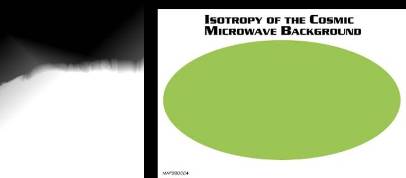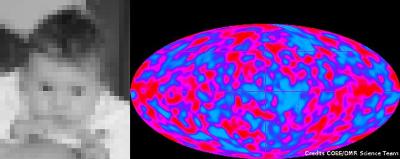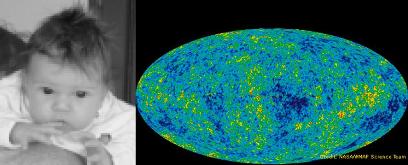Baby Universe Book
I am sure most of you have or have seen those pretty (or sissy, depends on the reader) album parents make for their baby. A blue or pink book where they write stuff like the story of how the baby was born, the first tooth: when and how did it happen, the first fallen tooth.. etc and of course everything is accompanied by pretty photos (starting with the strange black-and-a little white photo of the Martian version of the baby in mommy’s womb). This is what people call “Baby Book”
Well, believe it or not, Baby Universe has also such an album.. Now, I am not going to enter in a discussion about who’s the mommy and the daddy in this case..the memory album of Baby Universe has been made by some people call cosmologists. Of course the cosmologists need a special “camera” which can photograph the past.
In 1964 Arno Penzias and Robert Wilson discovered that the sky is filled with an electromagnetic radiation barely observed with a radio telescope. That was the Cosmic Microwave Background (CMB) radiation, named like this because it was later observed that it has a wavelength in the microwave regime.
What Penzias and Wilson have seen then and what made them Noble prize winners six years later was a picture of Baby Universe. At that time, all the “camera” (a.k.a the radiotelescope) could capture was a proof that something is there and it comes from a long way in the past. To put it in pictures, the first picture of the Baby Universe had about this quality:
The CMB is the relic radiation coming from Big Bang (the birth of Baby Universe). It’s made out of photons that “left home” and started traveling freely when the Universe was about 380 000 years old (in the so-called “last scattering epoch”). These photons altogether make the full photo of the Baby Universe, and of course, just like pixels, they have slightly (but very important) different temperatures. These differences are called the CMB anisotropies.
Looking at these anisotropies the cosmologists can take a photo of the Baby Universe and consequently they can tell how did the Universe look like immediately after the birth, when did the first “tooth” grew out (meaning when did the first structures in the Universe were created)..and also how will the Universe will be when older, what is the shape of the Universe (is it flat, open or closed), what is it made from..etc..
In the ‘90s, the science team of COBE experiment build the first “camera” that could see the anisotropies of the CMB and in 2006 its leaders, John Mather and George Smoot, got the second Nobel Prize in the field. The picture of Baby Universe was about this good:
Then in 2008 a NASA experiment, WMAP, took a much better picture of the Universe:
Still, the image of the Baby Universe is blurry, and questions remain for example about that time called inflation, when Baby Universe had a huge growing spurt and about the Dark Energy that the Baby Universe had, that grew along with it and became dominant today..etc..
This is why ESA built Planck Microwave Observatory, the first European mission designed to study the CMB.
On May 14th Planck was successfully launched onboard an Ariane 5 ECA from Europe’s spaceport in Kouru, French Guiana.
The detectors are looking for variations in the temperature of the Cosmic Microwave Background photons that are about a million times smaller than one degree; this is, as Planck scientists say, comparable to measuring from Earth the body heat of a rabbit sitting on the Moon.
To achieve this, Planck’s detectors must be cooled to extremely low temperatures, some of them being very close to absolute zero (–273.15°C, or zero Kelvin, 0K).
For almost 15 months (the normal lifetime of the mission) Planck will scan the entire sky twice to build a CMB map that will have an unprecedented precision and angular resolution.
The processed data acquired by Planck will then be delivered to the worldwide community towards the end of 2012 and, as Planck team promise, will keep both cosmologists and astrophysicists busy for decades to come





Recent Comments